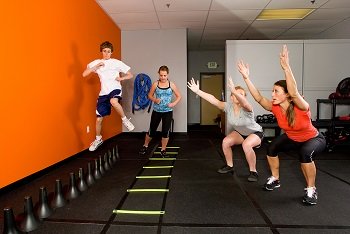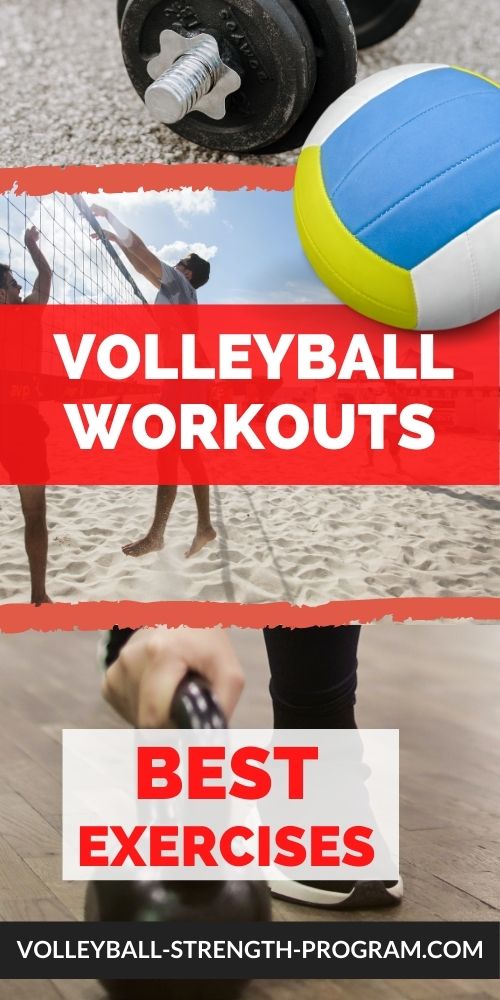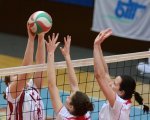Volleyball Workouts
Key exercises and specific to training
Volleyball workouts are important for success in volleyball.
Low Impact Plyometrics
Plyometrics is a type of exercise that's designed specifically to improve fast powerful movements.
Also referred to as jump training, plyometrics improves the function of the nervous system.
When performing plyometric movements, the muscles are loaded and then contracted in rapid sequence.
Fast change of direction movements improve the elasticity and innervations of the muscles and surrounding tissues.
Plyometric exercises result in volleyball players jumping higher, running faster, and hitting harder.
Low impact plyometrics are becoming popular exercises for volleyball players.
Performing a low impact plyometric workout at the beginning of
volleyball practice will help improve court quickness and explosive
power.
To make a big impact, volleyball workouts and practices should include at least 10 to 15 minutes of low impact plyometrics.
The following are example exercises...
- ankle hops in place
- front to back hops over a single cone
- side to side hops over a single cone
- one leg front to back speed drill over a line
- one leg side to side speed drill over a line
- two foot scissors dot mat drill
- two foot round the world dot mat drill
- continuous cone hops over consecutive cones
- continuous sideways cone hops over consecutive cones
If you enjoyed these tips and would like to keep it close to you at any time, just save this pin to your Pinterest Volleyball Training Board.
Bodyweight Circuit Training
Training using your own bodyweight as resistance is a great way to get in shape for volleyball.
The following exercises work your core while also strengthening key muscles.
- ab wheel
- push ups
- physioball back extensions
- reverse hypers on a bench
- fluttering abs
- push up position shoulder touches
- push up position hips in
- front plank
- side plank
Core Training for Volleyball
Free Weights
Free weights are great for volleyball workouts.
Weight training with machines isn't the optimal way to strength train for volleyball. Take
advantage of any chance you get to workout using free weights.
Free weights, especially dumbbells, have many advantages over machines. The most
important advantage is how the free weights make you work to stabilize the
weight. Free weights are considered more "functional" because of how muscles
work similar to being used in everyday life.
Strength Training for Volleyball
The following are great strength training exercises that involve free weights.
- two leg barbbell RDL
- single leg dumbbell RDL
- two leg dumbbell front squats
- single leg squats
- alternating dumbbell bench press
- pull ups
- inverted rows
- hip thrusts
- physioball leg curls
- glute ham raises
Important Tip for Volleyball Workouts:
It's important to mention that there are different methods of strength training using weights.
Generally, the heavier the weight, the more you're training for strength.
If you use lighter weight, you'll need more repetitions. This type of training is more for developing muscular endurance.
To build strength, you need to focus on heavier weight, with fewer repetitions.
For example, let's say you are peforming front squats.
If your workout consists of 3 sets of 15 repetitions, this type of training will result in improving muscular endurance
and size, rather than increased strength.
To increase strength, the rep range should be between 1 and 8. With strength
being the goal, it's common for athletes to
perform 5 sets of 5 repetitions for major
lifts such as front squats, deadlifts, and the bench press.
Anaerobic Conditioning
Volleyball is much more anaerobic than aerobic.
You have likely had a coach make you run wind sprints at practice. This is a form of anaerobic conditioning.
An example of aerobic conditioning would be running 3 miles.
Generally, if what you're doing is paced with no rest, it's considered aerobic.
The majority of plays in volleyball involve quick explosive movements with some rest in between.
Therefore, the best way to train for volleyball is with anaerobic style of training.
The following are popular volleyball conditioning methods that involve anaerobic exercise.
- low impact plyometrics mixed in with some speed and agility
- volleyball approaches and block jumps
- court suicides
- 200 meter sprints
Volleyball › Volleyball Conditioning › Volleyball Workouts
ACCESS MY STRENGTH SECRETS





